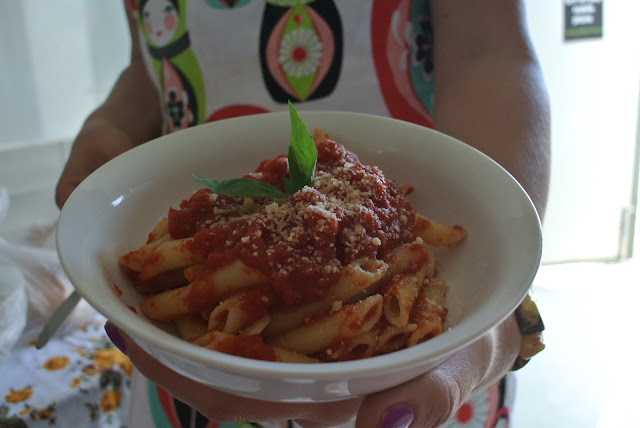Passata Day or "Tomato Day" as it is known by Italians around the world is when tomatoes are at their most abundant and families and friends get together to make passata to last them until the next tomato season. Every Italian family has their own recipe and of course their own recipe is the true and only way to make passata.....
 |
| Passata, simply tomatoes and a basil leaf in a bottle |
I recently attending a Passata Making class, run by Maria from the
Bulleen Art and Garden Centre. Maria is striving to keep this tradition alive in her family and pass it on to others that may have let the tradition lapse, or want to start the tradition themselves. She has her husband Ciro and daughter Sophie and son Andrew here to help us.
 |
| 12 Boxes of Roma Tomatoes waiting to be cored, cooked and bottled. |
To start with you get a box of Roma Tomatoes, these are washed cored, and any rotten parts were removed so that they are ready to be blanched.
 |
| Some of us were faster than others and more experienced tomato corers! |
Chiro is in charge of bringing the old copper cauldrons up to the boil to blanch the tomatoes.
 |
| Hundreds of tomatoes simmering away..... |
He uses a fire to heat them rather than gas to get the water up to the boil quickly. You can do this at home in a small scale in a stock pot. Once the tomatoes have been bought up to the boil they are boiled for 3-4 minutes and then drained.
 |
| Tomatoes are removed and drained of any excess water before they enter the extracting process |
Now comes the fun part the "passing" of the tomatoes through a separator or fancy sieve. Many Italian families own these machines, basically they separate the seed and peel away from the flesh. You can do this through a sieve or a small scale sauce machine at home.
 |
| The "passing" of the tomatoes.. the literal translation of "Passata". |
The cooked tomatoes go into the top of the machine and then are passed through two more times to ensure all the pulp is extracted, the sauce is then mixed to ensure an even consistency.
 |
| This is where it starts getting messy.... |
Meanwhile the jars are prepared and a single basil leaf is placed in the bottom of each jar before the sauce is added.
What surprised me most is that passata is basically just tomatoes passed trough a mechanical sieve, then preserved in a jar with a basil leaf, no salt, no acid, no sugar!
Next each of the jars are filled with the sauce and a lid is added.
 |
| Traditionally old beer bottles were used to store the Passata in.... you could imagine the mess in filling these ones up! |
Once the jars are filled they are put back into the the cauldrons for the preserving process to take place.
 |
| Over bottles are placed in the cauldrons for preserving |
The bottom of the cauldron is lined with old towels, then the bottles are stacked tightly on top.
 |
| The old towels are added so that the jars don't bump each other and crack! |
Boiling water is added and then the jars are weighed down with bricks. They are cooked for 30 minutes and then are left to cool until the next day.
The passata is ready to be used straight away.... it can be used by itself or added to make what ever takes your fancy.
 |
| Maria, whipping up a simple tomato pasta with the passata for lunch |
For lunch we had a simple sauce of garlic, olive oil and basil, served on spaghetti with tomatoes, topped with parmigiana....Buono!
 |
| The passata was so delicate in flavour it was delicious. |
Maria was a fantastic teacher and I would recommend this course to anyone who wants to learn how to make Passata and enjoys a hands on course. She also takes some preserving classes and classes around sustainable gardening you can check out her website
here.
Thanks to Maria, Ciro, Sophie and Andrew for making the day so enjoyable, I look forward to eating my 12 bottles of Passata over the next few months!